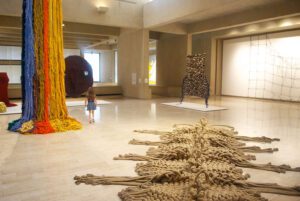This traveling exhibition is curated by Jenelle Porter of the Institute of Contemporary Art, Boston. The Des Moines Art Center presentation is organized by Senior Curator Gilbert Vicario.
The revolutionary politics of Fiber: Sculpture 1960–Present are alive and valuable but their presence is hard to read as more than a historical artifact. This dual position of vitality and preservation—the critique laying in state—uses suspended animation to prop itself up for equal parts of intellectual intrigue and broad appeal.
The entry of the show is unapologetically pragmatic. It situates fiber amongst the expected forms of modern art. Nets of color abound. Jean Stamsta’s large and playful Orange Twist (1970) is in every way a sculpture of the 70s. If not for its scale and position it could be a macramé wall hanging. Alan Shields has three fine works here. Two Untitled pieces from 1970 are suspended, painted lengths of yarn that are impossible to divorce from Barnett Newman’s Onement zips. Nina Got it for 100 Francs (1971) is a lush color field of open weaving. Paint is inextricable from the faint dimensionality of its weft, but stringed beads are laced in and throughout, ensuring that any Greenbergian flatness is a playful allusion to a past best left behind. It implies narrative and rhythm without resolving either. Diane Itter’s captivating miniatures are knotted thread in patterns without a backing fabric, neither painting nor sculpture.
Two of the strongest works in the show are Faith Wilding’s Crocheted Environment, or “womb room,” originally made for 1972’s influential Womanhouse, and Sheila Pepe’s site-specific Put Me Down Gently (2014) commissioned for this travelling show.
Wilding’s recreated Environment is knobby and web-like, simultaneously unsettling and profoundly comfortable. Its tangles and bumpy protuberances are a child’s secret woodland fort made of found scraps with molds and worn magazines. Environment is inventive, dangerous, or gross in a way that immediately confers intimacy and self satisfaction.
Pepe’s Put Me Down Gently is installed throughout all three floors of the Des Moines Art Center’s Meier wing. Impactful and potent, it is generous with surprises. Cords dangle seeking new places to root as they penetrate the hidden crevices of the interior’s perforated architecture. At home on the moon as anywhere else, a Meier building is wealth disinterested in context. It declares itself like globalized contemporary art pioneers emerging markets. Put Me Down Gently invades the Meier in a manner precisely reversed from, say, Sam Taylor Wood in Johannesburg’s second biennale.
Both works sprawl and tangle and easily assume power. One does so in a sanctioned and controlled room, intended for viewers to inhabit and absorb. Beginning from a more advanced platform, Pepe’s work explodes and grows, sending tendrils to seek new ground for its empire like a spider plant.
Much of Fiber is stunningly beautiful. This belies its second conundrum. High craft is itself potentially disrupting in the current art climate, but it opens a fallback on derisive and historically cruel comments against a medium tied to women’s work and minority positions. Specifically, much of it can comfortably end its reading as decorative. Individually the works indict the under-representation of fiber as a potent sculptural force. Its practitioners are sophisticated and radical. Yet the cool grandeur of the 1968 Pei wing causes the full installation to read like a world-class Pinterest board. The incitement of spectacle is not to overthrow but to consume. Less inherently political, Francoise Grossen’s Inchworm I lays on the floor, almost purely an intrigue of form. This is not to say it doesn’t suggest an artisanally knotted jute rug from Design Within Reach or CB2.
Perhaps it is their synchronicity. Sheila Hicks’ 2013–2014 Pillar of Inquiry/Supple Column (an astonishing and enormous rainbow column of spilling fibers) and Magdalena Abakanowicz’s 1969 Abakan Violet are individually fresh and astonishing, yet dated in this space. They are signifiers of self-congratulation for moving beyond a previous generation’s problems. We are only asked to be the already-enlightened thumbing through an Emory Douglas anthology and ‘liking’ a post supporting Rodney King or Chris Brown. This is an enormous contribution to the advancement of women in the arts, and we are on the verge—as close as we have ever come—to electing the first woman President of the United States, yet there is nothing urgent. No hotly felt call to action. It feels, instead, like a display of assurances towards continued wealth and prosperity that almost no one can reach.
Rosemarie Trockel’s Untitled (2004) is the single piece in the show that I can’t shake free from. Positioned like an afterthought in the slightly empty-feeling lower Pei it is overshadowed by Xenobia Bailey’s beckoning Sistah Paradise’s Great Walls of Fire Revival Tent (2002) and Ernesto Neto’s melodically touchable and traversable Soundway. Despite its exuberant hook and latch foot-long yarn upholstery and green legs Trockel’s work reads exactly like a covered Barcelona bench. It is created to frustrate function, to inspire crafty re-creation, to collapse kitsch, mass-market materials, luxury goods, and art.
This is the resting place of fiber in 2015. It is a confluence of art and craft, politics and commerce. It demonstrates the limits of beauty and scale. Assembled in an overdue history, it holds many of contemporary art’s knottiest problems.
Preserved revolution makes Fiber a paragon for contemporary museum shows. Often spectacular, it draws unlikely museum-goers into its party, hoping some are caught, altered, and released. Still, revolutionary work in a contemporary museum rings like bells in Petrograd.
Mat Greiner
FIBER: SCULPTURE 1960 – PRESENT
May 9 – August 2, 2015 Des Moines Art Center, Iowa
Volume 30 number 1, August / September 2015 pp 32-33
